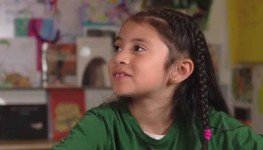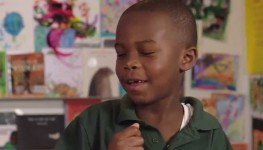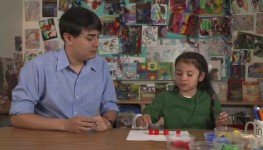Academics
Careers
Overview of Kindergarten Common Core Mathematics
Kindergarten "I Can" Statements
Khan Academy Resources Aligned to NWEA RIT Scores
(Ask your child's teacher for his/her NWEA RIT.)

Can your kindergartner add and subtract?

Does your kindergartner really understand addition and subtraction?

Can your kindergartner solve simple word problems?
What Your Child Will Learn
Count to 100 by ones and by tens. (K.CC.1) Count forward starting with any number (instead of having to begin at 1). (K.CC.2) Write numbers from 0 to 20. (K.CC.3) When counting objects, say the number names in order, pairing each object with one and only one number name and each number name with one and only one object. (K.CC.4)
Understand that the last number name said tells the number of objects counted. The number of objects is the same regardless of their arrangement or the order in which they were counted. (K.CC.4) Understand that each successive number name refers to a quantity that is one larger. (K.CC.4) Count to answer “how many?” (K.CC.5) Identify whether one group of objects is greater than, less than, or equal to the number of objects in another group (K.CC.6) Compare two numbers between 1 and 10 presented as written numerals. (K.CC.7)
Vocabulary
One-to-one Correspondence: Students assign one number to each object as they count
Count On: Starting at a given number and counting forward from that number
Greater Than: A number that has a higher value than another number
Less Than: A number that has a lower value than another number
Equal: Having the same valueVocabulary
Activities at Home
Play the license plate game with numbers as you walk through your neighborhood. Have them look for a 1 on a license plate. Then find a 2, then a 3, and so on.
Write your name and a family member’s name. How many letters are in your name? How many are in your family member’s name? Which name has more?
Look through a store ad. Cut out numbers 0-20. Put the numbers in order from least to greatest.
Grab a handful of an item, cereal, beans, etc. Estimate how many pieces you grabbed. Now count them. Was your estimate close?
Estimate how many spoonfuls it take to finish a bowl of cereal. Count each spoonful as you eat.
Walk around your home. Count how items are plugged into the wall.
Show the number 5 in as many ways as you can. Use pictures and numbers.
Learning Links
Peg + Cat (PBS)
Additional Learning Links for the Kindergarten Counting and Cardinality Standards: Click Here
What Your Child Will Learn
Make or break apart numbers from 11 to 19 into ten ones and some more ones. Use objects or drawings, and record each with an equation
(e.g., 18 = 10 + 8) (K.NBT.1)
Vocabulary
Place Value: The value of the place of the digit in the number (For example: in 27, 2 is in the 10's place and is worth 20)
Compose: Putting numbers together to make a new number (For example: 5+10=15)
Decompose: Breaking a number apart (For example: 15=8+7)
Equation: A mathematical statement containing an equal sign, to show that two expressions are equal
Add: To join two or more numbers
Subtract: To take one quantity away from another
Ten: A group of ten ones
Activities at Home
Use a stick of spaghetti to represent 10 and marshmallows to represent ones. Represent the numbers 12, 13, and 16 with the spaghetti and marshmallows.
Use a popsicle stick to represent a ten and beans to represent ones. Using a deck of cards, give your child a 10 card, and draw another number card, then add the numbers together and show the number with sticks and beans.
Walk from one end of the kitchen to the other and count how many steps, then show how many steps were taken with sticks and beans.
Learning Links
Additional Learning Links for Kindergarten Number and Operations in Base Ten Common Core Stanards: Click Here
Vocabulary
Attribute: A characteristic of an object that students use to define the object.
Example:Thin, thick, small, large, 3 sides, 4 sides, etc.
Length: The distance between two points or objects
Weight: A measure of how heavy something is
Sorting: Grouping objects based on similar attributes
Non-Standard Units of measurement: Any real item that can be used to measure.
Examples include paperclips, cookies, pennies, or yarn
Activities at Home
Trace your foot with chalk outside. Trace a friend’s or family member’s foot too. Which foot is longer?
Sort a bag of skittles or other candy by color. Count each color. What color has the most? What color has the least?
Get three different cups. Put them in order from shortest to tallest.
Sort the mail by name. Who has the least amount of mail? Who has the most amount of mail?
Find 3 objects in the home that are longer than your shoe.
Learning Links
Liquid: More or Less
Additional Learning Links for Kindergarten Measurement and Data Common Core Standards: Click Here
What Your Child Will Learn
Represent addition and subtraction in many ways. (K.OA.1) Solve addition and subtraction word problems within 10 (K.OA.2) Break apart numbers into pairs in more than one way (e.g., 5 = 2 + 3, 5 = 4 + 1, and 5 = 5 + 0). (K.OA.3) Find the number that makes 10 when added to a given number. (e.g., If you have 6 what number is needed to make 10?) (K.OA.4) Fluently add and subtract within 5. (K.OA.5)
Vocabulary
Add: To join together two or more numbers
Subtract: To take one quantity away from another
Equation: A mathematical statement containing an equal sign, to show that two expressions are equal
Decompose: To break a number into smaller parts to simplify computation. Example: 15 = 10 + 5.
Equal Sign: Having the same amount or value
Compose: To put decomposed numbers back together. 10 + 5 = 15
Activities at Home
Use cereal pieces to solve the following problem: Mason has 10 pieces of cereal. He eats 4 pieces. How many pieces are left?
How old are you now? Subtract one from that number and record it. Add 3 to that number and record it.
Count backwards from 100. Skip count to 100 by 10s. Which took longer? Write your answer.
Go outside and find two clovers. Write an equation to show how many leaves are on both clovers.
Use some fruit to solve the following problem: Ken has 5 bananas in a bunch. He eats some. There are 3 left. How many bananas did he eat?
Ben had 4 chairs at his kitchen table in the morning. After school there was only 1 chair at the kitchen table. How many chairs are missing?
Learning Links
Additional Learning Links for Kindergarten Operations and Algebraic Thinking Common Core Standards: Click Here
What Your Child Will Learn
Describe objects in the environment using names of shapes, and tell positions of these objects using terms such as above, below, beside, in front of,
behind, and next to. (K.G.1) Correctly name shapes regardless of their size or orientation. (K.G.2) Identify shapes as two-dimensional (lying in a plane, “flat”) or three- dimensional (“solid”). (K.G.3) Compare two- and three-dimensional shapes describing their similarities, differences, parts (e.g., number of sides and vertices/“corners”) (K.G.4) Model shapes in the world by building and drawing shapes. (K.G.5) Put together simple shapes to form larger shapes. (K.G.6) Vocabulary
Two-Dimensional (flat): The outline of a shapesuch as a triangle, square, or rectangle
Three-Dimensional (solid): A shape having length, width, and height
Face: The flat surface of a solid figure
Side: Line-segments of shapes
Square: A four-sided shape with equal sides and corners
Rectangle: A four-sided shape with two sets of sides that are equal and parallel, and four right angles
Circle: A flat shape with no sides or corners
Triangle: A three-sided figure
Hexagon: A shape with six sides
Sphere: A solid shape similar to a basketball
Cylinder: A 3-D shape with two circular faces
Cube: A 3-D shape with six square faces
Cone: A 3-D shape with a curved surface and one circular face
Activities at Home
Look around your home for solid shapes. Name at least 3 solid shapes.
Look around your home for flat shapes. Draw at least three of the shapes.
Look around your home for circles. Count them and record how many you found.
Use bendy straw, toothpicks, or pipe cleaners to many shapes as you can. Record the names of your shapes.
Make a picture using 2 circles, 3 triangles, & 1 rectangle. Describe to a friend how you made it.
Explore Position words. Use toys to model before, after, above, below, and beside. Describe using attributes. Ex. The blue car is behind the red car.
Learning Links
Additional Learning Links for Kindergarten Geometry: Click Here